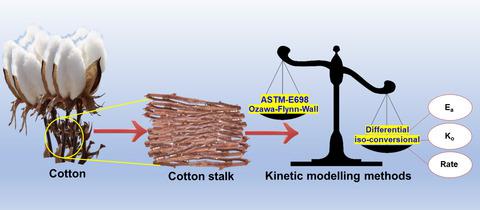当前位置:
X-MOL 学术
›
Energy Sci. Eng.
›
论文详情
Our official English website, www.x-mol.net, welcomes your feedback! (Note: you will need to create a separate account there.)
Characterization and kinetic modeling for pyrolytic conversion of cotton stalks
Energy Science & Engineering ( IF 3.8 ) Pub Date : 2021-08-15 , DOI: 10.1002/ese3.961 Samer Fawzy 1 , Ahmed I. Osman 1, 2 , Charlie Farrell 3, 4 , Ala'a H. Al‐Muhtaseb 5 , John Harrison 3 , Ahmed S. Al‐Fatesh 6 , Anis H. Fakeeha 6 , John Doran 7 , Haiping Yang 8 , David W. Rooney 1
Energy Science & Engineering ( IF 3.8 ) Pub Date : 2021-08-15 , DOI: 10.1002/ese3.961 Samer Fawzy 1 , Ahmed I. Osman 1, 2 , Charlie Farrell 3, 4 , Ala'a H. Al‐Muhtaseb 5 , John Harrison 3 , Ahmed S. Al‐Fatesh 6 , Anis H. Fakeeha 6 , John Doran 7 , Haiping Yang 8 , David W. Rooney 1
Affiliation

|
Herein, cotton stalk biomass was initially characterized to understand its physicochemical properties as a raw material for biochar production. Furthermore, thermal analysis was conducted using thermogravimetric analysis (TGA), and the results were further utilized to evaluate the cotton stalk's kinetic behavior under thermal decomposition in an inert environment. Advanced kinetics and technology solutions (AKTS) software was for the first time employed to compute the kinetic parameters of cotton stalk pyrolysis, as well as provide kinetic predictions under isothermal conditions. Three methods were used to compute the activation energy (Ea) value, namely ASTM-E698, Flynn-Wall-Ozawa (FWO), and Friedman's differential iso-conversional model. The results obtained using the ASTM-E698 method indicate an activation energy of 127.23 kJ·mol−1. Furthermore, the FWO method presented an Ea value ranging 35-250 kJ·mol−1. The differential iso-conversional method is the most robust approach as it adequately represents the complex nature of lignocellulosic biomass decomposition, showing an Ea range between 4 and 250 kJ·mol−1. Based on the differential iso-conversional method, kinetic predictions under isothermal conditions were provided. The predictions offer valuable insight for industrial-scale biochar project developers in relation to production throughput optimization. Furthermore, the kinetic parameters obtained can be utilized in process modeling.
中文翻译:

棉秆热解转化的表征和动力学建模
在此,棉花秸秆生物质最初被表征以了解其作为生物炭生产原料的理化特性。此外,使用热重分析 (TGA) 进行热分析,并将结果进一步用于评估在惰性环境中热分解下棉秆的动力学行为。先进动力学和技术解决方案 (AKTS) 软件首次用于计算棉秆热解的动力学参数,并提供等温条件下的动力学预测。使用三种方法计算活化能 ( E a) 值,即 ASTM-E698、Flynn-Wall-Ozawa (FWO) 和 Friedman 的微分等转换模型。使用ASTM-E698方法获得的结果表明活化能为127.23 kJ·mol -1。此外,FWO方法呈现的E a值范围为35-250 kJ·mol -1。差分等转化方法是最稳健的方法,因为它充分代表了木质纤维素生物质分解的复杂性质,显示E a范围在 4 到 250 kJ·mol -1 之间. 基于微分等转化方法,提供了等温条件下的动力学预测。这些预测为工业规模的生物炭项目开发人员提供了与生产吞吐量优化相关的宝贵见解。此外,获得的动力学参数可用于过程建模。
更新日期:2021-10-03
中文翻译:

棉秆热解转化的表征和动力学建模
在此,棉花秸秆生物质最初被表征以了解其作为生物炭生产原料的理化特性。此外,使用热重分析 (TGA) 进行热分析,并将结果进一步用于评估在惰性环境中热分解下棉秆的动力学行为。先进动力学和技术解决方案 (AKTS) 软件首次用于计算棉秆热解的动力学参数,并提供等温条件下的动力学预测。使用三种方法计算活化能 ( E a) 值,即 ASTM-E698、Flynn-Wall-Ozawa (FWO) 和 Friedman 的微分等转换模型。使用ASTM-E698方法获得的结果表明活化能为127.23 kJ·mol -1。此外,FWO方法呈现的E a值范围为35-250 kJ·mol -1。差分等转化方法是最稳健的方法,因为它充分代表了木质纤维素生物质分解的复杂性质,显示E a范围在 4 到 250 kJ·mol -1 之间. 基于微分等转化方法,提供了等温条件下的动力学预测。这些预测为工业规模的生物炭项目开发人员提供了与生产吞吐量优化相关的宝贵见解。此外,获得的动力学参数可用于过程建模。



























 京公网安备 11010802027423号
京公网安备 11010802027423号